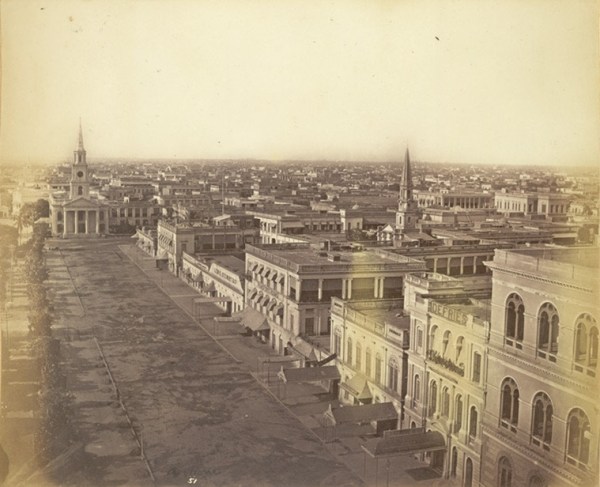In the chaos of the Dalhousie neighbourhood in central Kolkata, many of its streets and roads are lost in the continuous traffic and swarm of passersby. But if one is lucky enough to find oneself in the area on a quiet morning or afternoon, and looks down the road from the 204-year-old St. Andrew’s Church, it becomes easier to identify Old Court House Street from the network of crisscrossing roads here.
This street has a fascinating history. The Calcutta Review of 1852 provides some insight into why the street was so named. “Old Court House Street, parallel with the Mission Row, is so called from the Old Court House, or Town Hall, which stood at the northern extremity of the street, on the site of St. Andrew’s Church,” an entry in the Review of 1852 says.
This photograph of the Old Court House Street from the ‘Walter Hawkins Nightingale (PWD) collection: Album of views of Calcutta, was taken by A. De Hone in the late 1870s. Old Court House Street is located on the eastern side of Dalhousie Square. In this southern view, the Maidan is visible in the far distance. Photo credit: The British Library
According to this document, the Old Court House also housed a charity school, the first in Bengal, controlled by what appears to be the British, that was “feeding and educating twenty children for 2,400 Rs. annually”. It was erected sometime in 1727 during Robert Clive’s governorship, by one Mr. Bourchier, a merchant, who was afterwards appointed Governor of Bombay, the Review states.
It appears from the entries in the Calcutta Review that although several enterprises, including assembly rooms for balls, operated out of the building called the Old Court House, like its name suggests, it did function as a courthouse, albeit a small one, and served as a predecessor to the Supreme Court that was constituted in 1774.
Subscriber Only Stories
Public documents show that the building was extended to accommodate the growing courthouse in 1810 and remains standing today, albeit in a dilapidated condition, and has been converted into a residential building.
 This photograph of the Old Court House Street from the ‘Walter Hawkins Nightingale (PWD) collection: Album of views of Calcutta, was taken by A. De Hone in the late 1870s. Old Court House Street is located on the eastern side of Dalhousie Square. In this view, St. Andrew’s Church is visible on the north corner of Old Court House Street and Lal Bazar Street. Photo credit: The British Library
This photograph of the Old Court House Street from the ‘Walter Hawkins Nightingale (PWD) collection: Album of views of Calcutta, was taken by A. De Hone in the late 1870s. Old Court House Street is located on the eastern side of Dalhousie Square. In this view, St. Andrew’s Church is visible on the north corner of Old Court House Street and Lal Bazar Street. Photo credit: The British Library
In her book ‘Calcutta: Past and Present’, Kathleen Blechynden writes, “The Court House which Mr. Bourchier had built, stood for sixty years on the site where St. Andrew’s now stands; it appeared to not have been seriously injured during the siege of the town, and as the Mayor’s Court only occupied a part of the building, the remainder was available for various purposes. In 1762, the Court House was greatly enlarged by the addition of verandahs twenty-five feet broad to both floors on the south, an additional saloon with a room at each end, arches opening all around, and a dancing saloon, in order that it might be used as an exchange, post office, public entertainment and assembly rooms…..These were the best days of the Old House, the Mayor’s Court had been abolished a few years before, and gradually the tide of fashion ebbed away to rival the assembly rooms, the theatre and other places of entertainment; the floors became unsafe for dancing, and finally, the ‘Old Court House’ was pulled down in 1792, and only its name remains commemorated in the Old Court House Street.”
Blechynden writes that in 1815, the East India Company government gave the site of the Old Court House for the construction of St. Andrew’s Church. It is clear from archival documents that this was the “fashionable” part of Calcutta, one where the residents were largely all Europeans. In his book ‘The Condition, Improvement and Town Planning of the City of Calcutta and Contiguous Areas’ author E. P. Richards writes that Old Court House Street, like the other lanes and streets that it was surrounded by, for a significant part of its history, was still largely occupied by the British and other Europeans, and the buildings that remain standing and documents that describe their original purpose, are a testament to that.
Advertisement
The Old Court House Street is flanked by the edges of the Writer’s Building and the Lal Dighi tank on one side and rows of old colonial buildings on the other. A significant part of the street has been dug up to accommodate the new metro lines under construction. The Old Court House has been long gone.
Source: https://news.google.com/__i/rss/rd/articles/CBMiiAFodHRwczovL2luZGlhbmV4cHJlc3MuY29tL2FydGljbGUvY2l0aWVzL2tvbGthdGEvc3RyZWV0d2lzZS1rb2xrYXRhLW9uLW9sZC1jb3VydC1ob3VzZS1zdHJlZXQtdGhlLW9sZC1jb3VydGhvdXNlLWRvZXMtbm90LWV4aXN0LTgzMTQ4MDMv0gEA?oc=5

